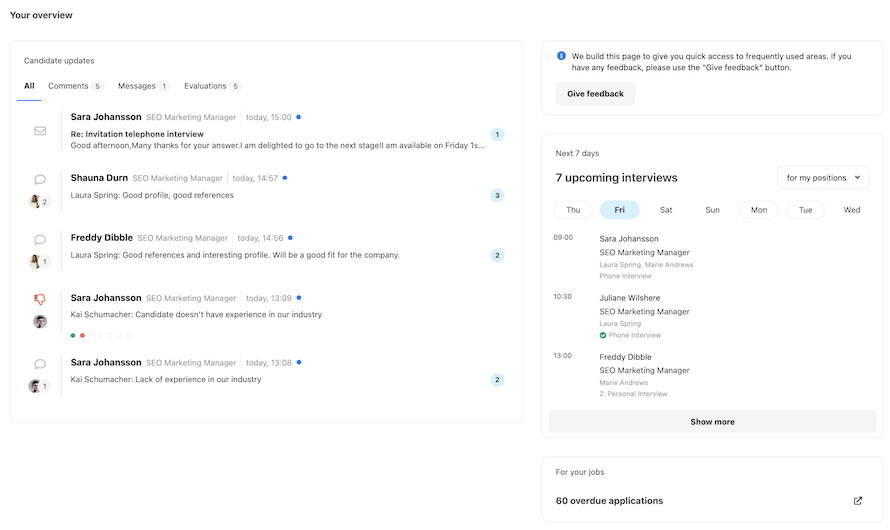
Optimise recruitment workflows
Optimise your recruitment workflow with Personio's powerful recruitment software.
Explore our productInternal Recruitment: How Do You Build A Winning Process?

Can internal recruitment result in the best candidates for your role? When the time comes to start recruiting for just about any role, the question is: Who do you choose? Moreover, how do you know if they can really do the job?
If you take a little bit of time, and not too much effort, internal recruitment has the potential to reveal the best possible candidates from within your organization. What you need, though, is the structure and process to make it work well.
Communication helps define culture. Download our guide to corporate culture today.Contents
- 1What Is Internal Recruitment?
- 2The HR Playbook for Internal Recruitment
- 3Factors to Consider Before Hiring Internally
- 4How Do You Get Started On Internal Recruitment?
- 5What Is The Best Way To Advertise An Internal Role?
- 6What Are The Different Types Of Internal Recruitment?
- 7Why Does Talent Management For Internal Recruitment Matter?
- 8Can Internal Recruitment Boost Your Talent Pool?
- 9Strengthen Your Organization Through Internal Recruitment
What Is Internal Recruitment?
As you might expect from the name, internal recruitment is when you hire employees from within your organization. Is it the best way to find new hires or to increase the number of people who work for you? By definition, no, since those you recruit will already be under the employ of your company. But, internal recruitment can result in getting the best possible candidate for the job. Of course, we will explain how a bit later on…
The HR Playbook for Internal Recruitment
Let's begin by detailing the various ways that internal recruitment works, its advantages, and disadvantages, and how you can get started implementing it today…
Pros and Cons: the Benefits and Disadvantages of Internal Recruitment
There are actually many and varied benefits, as we cover in this blog post on Internal Recruitment: Pros, Cons, and Important Steps to Take.
For example:
There is a smaller learning curve
Employees can potentially start more quickly
It might ultimately be cheaper (with no costs for advertising or using recruitment agencies).
You also (mostly) know what to expect from a candidate. The biggest benefit, though, is the importance of giving employees hope, opportunity, and confidence that they can thrive and grow in your company.
As we said in a previous blog post on recruitment, "From the employee’s point of view, new career prospects open up. This may involve a new professional focus, a promotion, more responsibility, or a higher salary." (You can find out more about the hows of recruitment and in our HR lexicon article on the subject.)
Of course, there are disadvantages, too. Internal recruitment isn’t always sunshine and roses. As Kate Russell says in the HR Magazine article, “Internal recruitment: right or wrong?”, “Unsuitable applicants will often apply for the position (and will probably have to be interviewed). You have to give some thought to how you will manage the feedback and keep employees motivated if they have been unsuccessful. It may be that unsuccessful internal applicants are disgruntled and make life difficult for the successful candidate.”
Create a great candidate experience

Organise applications, plan interviews and quickly evaluate candidates. Manage your entire hiring process with one tool with Personio.
Unlock Smoother HiringFactors to Consider Before Hiring Internally
Finding qualified applicants for any role can be a complex and challenging task.
The process (which you can read more about on this page on applicant sourcing) can involve many people, take a huge amount of work to set up (especially if you want to advertise a role across multiple portals or job boards), and require the attention of many members of your internal team during the hiring process (like during semi-structured interviews).
That is almost enough of a reason to skip external recruitment entirely. However, only recruiting people from your internal talent pool is not wise, since every company needs to increase its talent pool over time to avoid growing stale. It may not even be possible if the job’s skill set is something you have never hired for before.
The fact is, every recruitment organization needs to balance the different hiring techniques and approaches they use for the best results. It’s wise to make sure you’re optimizing your recruitment process itself, in addition to using internal recruitment techniques.
Is your company trying to get better at remote recruiting? Click here to learn more.
How Do You Get Started On Internal Recruitment?
To a large extent, the processes involved with recruitment are the same – whether you’re drawing from an internal or an external talent pool. The CIPD defines them as follows:
Define the role
Attract applicants
Manage the application and selection process
Make the appointment (i.e. hire them for the role)
When it comes to hiring internally, it is a bit easier in many ways. You still need to make sure you’ve analyzed the job, written a job description, and person specification – but the advertising is cheaper. That doesn’t mean it requires less thought, though.
Templates For Better Performance Reviews
Create a great candidate experience

Organise applications, plan interviews and quickly evaluate candidates. Manage your entire hiring process with one tool with Personio.
Unlock Smoother HiringWhat Is The Best Way To Advertise An Internal Role?
When it comes to getting the message ‘out there’ about an internal role, it pays to think like a marketer. Who’s your audience? Where do they hang out? How will they see the role? What will entice them to apply? Answer these questions, and you’ll know that your internal job advert will be seen.
There are obvious ways to share messages with potential internal candidates and less obvious ones. Obvious ones include:
Sending company-wide emails,
Asking all managers to inform their staff that the roles are available,
Putting messages on your intranet or internal comms channels (such as Slack / Teams)
Including information about open roles in internal meetings
Getting senior leaders to talk about the roles in company-wide presentations.
But there are also less obvious options and some ways of overcoming internal resistance:
Remember that people might not want to apply for internal roles if they think there’s a risk they won’t be chosen, or they can’t do the job. So make sure they know that training is available (if it is) to help them transition to the new role.
If people are office-based, put signs up in common areas like kitchens and even on the back of the toilet doors. If nothing else, it gives people something to read while they’re making a cup of tea or stuck in a cubicle.
Make sure that it is clear that hiring internal people is your preferred option and tell them why. Internal recruitment can form a very important part of your talent management strategy and help you attract, develop, and retain qualified employees if it’s done sensitively and with clarity and understanding.
What Are The Different Types Of Internal Recruitment?
Don’t forget that internal recruitment takes many forms. You don’t just have to promote people. You can also transfer them, or change the way they work with your company.
For example, you can move people from being freelance to full-time, or even get people who have left the company or retired to come back and work for you on a part-time basis.
Why Does Talent Management For Internal Recruitment Matter?
What does talent management have to do with internal recruitment? Let us explain.
Talent management is a holistic corporate strategy that aims to attract, develop, motivate, and retain high-performing employees over the long term.
In this way, talent management concentrates on individual high achievers, improving company performance, and aiming to over-achieve corporate objectives. (To find out more about how to build a proper talent management strategy, take a look at this blog post).
Should You Include Talent Management As Part Of Internal Recruitment Strategies?
It makes sense to include internal recruitment as an effective part of your talent management strategy. This is because it allows you to promote your most talented employees from within.
In general, it gives people the opportunity to engage with roles that help your business do more while giving them a sense of personal growth and development. In some cases, it can actually help you retain employees who may have become disillusioned with their current roles by offering them room for growth – even if that role may be a lateral move.
Can Internal Recruitment Boost Your Talent Pool?
Most definitely. It is worth mentioning that attracting the most qualified employees possible is important for every single position. Sometimes, that talent is only available externally.
More often than not, though, there are people with those talents who already work for you.
The art of internal recruitment lies in making your internal candidates excited about the role, as well as reassured that they can make a move (either sideways or upwards). This is true even if they don’t have every single skill listed on the job description.
A great internal talent pool is actually a database-driven view of your employees. Sometimes, when you have enough data at your fingertips (for example – with a digital employee file), you might even be able to spot which candidates could do the job before they even consider it themselves!
Strengthen Your Organization Through Internal Recruitment
In essence, it is possible to get the best possible candidates using internal recruitment tactics. But, don’t forget, if you move someone internally you’ll then probably have to find someone to fill their role, too, and so the process begins again.
When that happens, it’s probably a good idea to put tools or processes in place to make recruiting and e-recruiting as seamless as possible. Fortunately, Personio can help. Get in touch to learn more about our HR software today.
